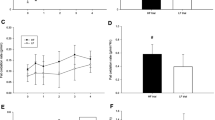Summary
After five days of almost continuous strenuous combat exercise and energy deficiency, 12 well-trained young men had a mean body fat loss of 2.7 kg and the average fat cell size was reduced from 0.34 Μg to 0.24 Μg. No significant changes were found in the total number of fat cells. For the group as a whole, the decrease in fat cell size was most pronounced in the gluteal subcutaneous region, followed by the abdominal region. No significant decrease in fat cell size was encountered in tissue samples from the femoral site. Before the course, and on the last day, the subjects accomplished a short-term bicycle exercise at 50% of the individual's \(\dot V\operatorname{O} _2 \). On day 5, positive correlations were found between the fat cell weights estimated in the gluteal tissue samples and the pre-exercise free fatty acid (FFA) levels (r=0.87, p<0.01), and also with the plasma free glycerol obtained five minutes after the bicycle exercise (r=0.93, p<0.001). These correlations were not apparent in the control experiment performed before the course. Further, no such relationship was found between the plasma metabolites and the fat cell size of the other body sites investigated. This finding may indicate that gluteal fat deposits are more important for energy provision than abdominal and, especially, femoral deposits.
Similar content being viewed by others
References
Aakvaag A, Bentdal Ø, Quigstad K, Walstad K, RØnningen H, Fonnum F (1978) Testosterone and testosterone binding globulin (to BG) in young men during prolonged stress. Int J Androl 1: 22–31
åstrand P-O, Rodahl K (1977) Textbook of work physiology, 2nd edn. McGraw-Hill, New York
Ballasse EO, Fery F, Neef M-A (1978) Changes induced by exercise in rates of turnover and oxidation of ketone bodies in fasting man. J Appl Physiol 44: 5–11
Cahill GF (1970) Starvation in man. N Engl J Med 282: 668–675
Durnin JVGA, Rahaman MM (1967) The assessment of the amount of fat in the human body from measurements of skinfold thickness. Br J Nutr 20: 681–689
Di Girolamo M, Mednlinger S, Fertig JW (1971) A simple method to determine fat cell size and number in four mammalian species. Am J Physiol 221: 850–858
Kral JG, BjØrntorp P, Scherstén T, SjØstrØm L (1977) Body composition and adipose tissue cellularity before and after jejunoileostomy in severely obese subjects. Eur J Clin Invest 7: 413–419
LaFontan M, Dan-Tran L, Berlan M (1979) Alpha-adrenergic antilipolytic effect of adrenaline in human fat cells of the thigh: comparison with adrenaline responsiveness of different fat deposits. Eur J Clin Invest 9: 261–266
Lehman EL (1975) Non-parametrics: Statistical methods based on ranks. Holden-Day, San Francisco, p 457
Lin ECC (1977) Glycerol utilization and its regulation in mammals. Ann Rev Biochem 46: 765–795
Opstad PK, Aakvaag A, Rognum TO (1980) Altered hormonal response to short term bicycle exercise in young men after prolonged physical strain, caloric deficit and sleep deprivation. Eur J Appl Physiol 45: 51–69
Rognum TO, Bjerve KS, Seip M, Trygstad O, Oseid S (1978) Fat cell size and lipid content of subcutaneous tissue in congenital generalized lipodystrophy. Acta Endocrinol 88: 182–189
Rognum TO, Vaage O, HØstmark AT, Opstad PK (1981) Metabolic responses to bicycle exercise after several days of physical work and energy deficiency. Scand J Clin Lab Invest 41: 565–571
Salans LB, Cushman SW, Weismann RE (1973) Studies of human adipose tissue. Adipose cell size and number in non-obese and obese patients. J Clin Invest 52: 929–941
Smith U, Hammersten J, BjØrntorp P, Kral G (1979) Regional differences and effect of weight reduction on human fat cell metabolism. Eur J Clin Invest 9: 327–332
Smith U (1980) Adrenergic control of human adipose tissue. Eur J Clin Invest 10: 343–344
SjØstrØm L, BjØrntorp P, Vrána J (1971) Microscopic fat cell size measurements on frozen-cut adipose tissue in comparison with automatic determinations of osmium-fixed fat cells. J Lipid Res 12: 521–530
Author information
Authors and Affiliations
Rights and permissions
About this article
Cite this article
Rognum, T.O., Rodahl, K. & Opstad, P.K. Regional differences in the lipolytic response of the subcutaneous fat depots to prolonged exercise and severe energy deficiency. Europ. J. Appl. Physiol. 49, 401–408 (1982). https://doi.org/10.1007/BF00441301
Accepted:
Issue Date:
DOI: https://doi.org/10.1007/BF00441301




